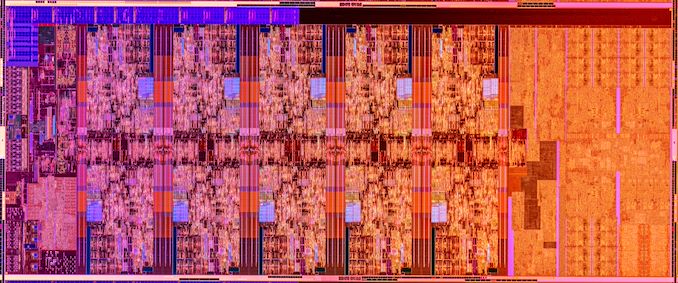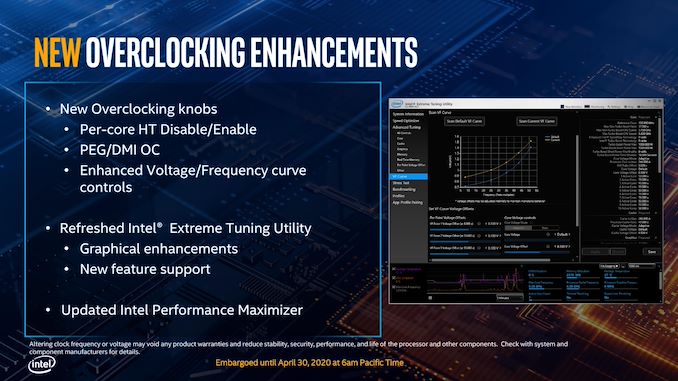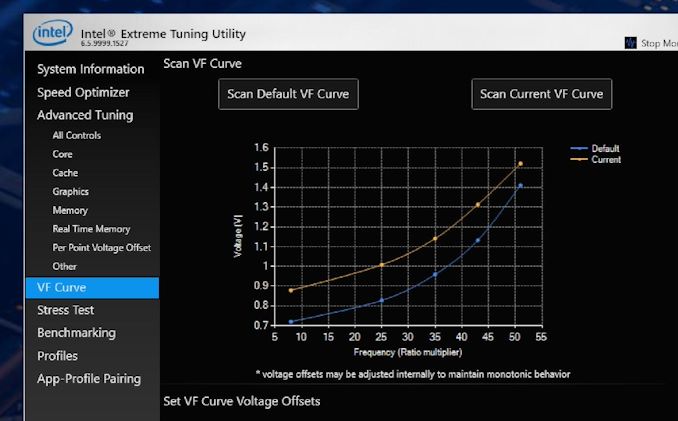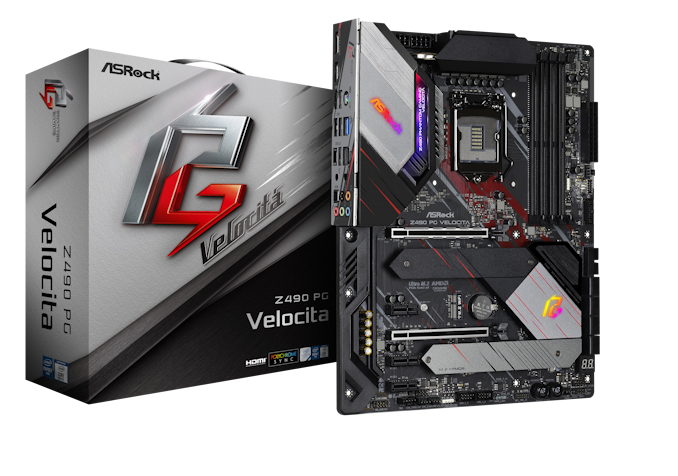Intel’s 10th Gen Comet Lake for Desktops: Skylake-S Hits 10 Cores and 5.3 GHz
by Dr. Ian Cutress on April 30, 2020 9:00 AM EST- Posted in
- CPUs
- Intel
- Overclocking
- 14++
- Z490
- Comet Lake
- B460
- H470
Socket, Silicon and Security
The new CPUs have the LGA1200 socket, which means that current 300-series motherboards are not sufficient, and users will require new LGA1200 motherboards. This is despite the socket being the same size. Also as part of the launch, Intel provided us with a die shot:
It looks very much like an elongated Comet Lake chip, which it is. Intel have added two cores and extended the communication ring between the cores. This should have a negligible effect on core-to-core latency which will likely not be noticed by end-users. The die size for this chip should be in the region of ~200 mm2, based on previous extensions of the standard quad core die:
- CFL 4C die: 126.0 mm2
- CFL 6C die: 149.6 mm2
- CFL 8C die: 174.0 mm2
- CML 10C die: ~198.4 mm2

Original 7700K/8700K die shots from Videocardz
The only silicon we know to be guaranteed inside each retail box is that the ten core parts have to have the 10C silicon. Beyond that, Intel could make any of the eight core Core i7 parts use either a native 8C silicon, or 10C silicon with two disabled cores. Similarly, the six core Core i5 could either be native 6C silicon, harvested 8C silicon, or harvested 10C silicon. We have reached out to Intel for clarification, given that in previous generations Intel sometimes offered different TDP values for the harvested dies. There's even a possibility that Intel could be reusing the same Coffee Lake silicon masks and just binning them to Comet Lake specifications.
For security, Intel is applying the same modifications it had made to Coffee Lake, matching up with the Cascade Lake and Whiskey Lake designs.
| Spectre and Meltdown on Intel | ||||||
| AnandTech | Comet Lake |
Coffee Refresh |
Cascade Lake | Whiskey Lake |
||
| Spectre | Variant 1 | Bounds Check Bypass | OS/VMM | OS/VMM | OS/VMM | OS/VMM |
| Spectre | Variant 2 | Branch Target Injection | Firmware + OS | Firmware + OS | Hardware + OS | Firmware + OS |
| Meltdown | Variant 3 | Rogue Data Cache Load | Hardware | Hardware | Hardware | Hardware |
| Meltdown | Variant 3a | Rogue System Register Read | MCU* | Firmware | Firmware | Firmware |
| Variant 4 | Speculative Store Bypass | Hardware + OS | Firmware + OS | Firmware + OS | Firmware + OS | |
| Variant 5 | L1 Terminal Fault | Hardware | Hardware | Hardware | Hardware | |
The fix for V3a has now changed from ‘Firmware’ to ‘MCU’, suggesting that Intel has added a microcontroller as a fix. We have asked Intel for clarification. Intel is now claiming that V4 is fixed through a combination of hardware and OS fixes.
Die Thinning
One of the new features that Intel is promoting with the new Comet Lake processors is die thinning – taking layers off of the silicon and in response making the integrated heat spreader thicker in order to enable better thermal transfer between silicon and the cooling. Because modern processors are ‘flip-chips’, the bonding pads are made at the top of the processor during manufacturing, then the chip is flipped onto the substrate. This means that the smallest transistor features are nearest the cooling, however depending on the thickness of the wafer means that there is potential, with polishing to slowly remove silicon from this ‘rear-end’ of the chip.
In this slide, Intel suggests that they apply die thinning to products using STIM, or a soldered thermal interface. During our briefing, Intel didn’t mention if all the new processors use STIM, or just the overclockable ones, and neither did Intel state if die thinning was used on non-STIM products. We did ask how much the die is thinned by, however the presenter misunderstood the question as one of volume (?). We’re waiting on a clearer answer.
Overclocking Tools and Overclocking Warranties
For this generation, Intel is set to offer several new overclocking features.
First up is allowing users to enable/disable hyperthreading on a per-core basis, rather than a whole processor binary selection. As a result, users with 10 cores could disable HT on half the cores, for whatever reason. This is an interesting exercise mostly aimed at extreme overclockers that might have single cores that perform better than others, and want to disable HT on that specific core.
That being said, an open question exists as to whether the operating system is set up to identify if individual cores have hyperthreads or not. Traditionally Windows can determine if a whole chip has HT or not, but we will be interested to see if it can determine which of my threads on a 10C/15T setup are hyperthreads or not.
Also for overclocking, Intel has enabled in the specification new segmentation and timers to allow users to overclock both the PCIe bus between CPU and add-in cards as well as the DMI bus between the CPU and the chipset. This isn’t strictly speaking new – when processors were driven by FSB, this was a common element to that, plus the early Sandy Bridge/Ivy Bridge core designs allowed for a base frequency adjustment that also affected PCIe and DMI. This time around however, Intel has separated the PCIe and DMI base frequencies from everything else, allowing users to potentially get a few more MHz from their CPU-to-chipset or CPU-to-GPU link.
The final element is to do with voltage/frequency curves. Through Intel’s eXtreme Tuning Utility (XTU) and other third party software that uses the XTU SDK, users can adjust the voltage/frequency curve for their unlocked processor to better respond to requests for performance. For users wanting a lower idle power, then the voltage during idle can be dropped for different multiplier offsets. The same thing as the CPU ramps up to higher speeds.
It will be interesting to see the different default VF curves that Intel is using, in case they are per-processor, per-batch, or just generic depending on the model number. Note that the users also have to be mindful of different levels of stability when the CPU goes between different frequency states, which makes it a lot more complicated than just a peak or all-core overclock.
On the subject of overclocking warranties, even though Intel promotes the use of overclocking, it isn’t covered by the standard warranty. (Note that motherboard manufacturers can ignore the turbo recommendations from Intel and the user is still technically covered by warranty, unless the motherboard does a technical overclock on frequency.) Users who want to overclock and obtain a warranty can go for Intel’s Processor Protection Plans, which will still be available.
Motherboards, Z490, and PCIe 4.0 ??
Due to the use of the new socket, Intel is also launching a range of new motherboard chipsets, including Z490, B460, and H470. We have a separate article specifically on those, and there are a small number of changes compared to the 300 series.
The two key features that Intel is promoting to users is support for Intel’s new 2.5 GbE controller, the I225-V, in order to drive 2.5 gigabit Ethernet adoption. It still requires the motherboard manufacturer to purchase the chip and put it on the board, and recent events might make that less likely – recent news confirmed by Intel has stated that the first generation of the I225 silicon is not up to specification, and certain connections might not offer full speed (down 10 Mbps from 2500 Mbps) depending on the end-point. As a result Intel is introducing new B2 stepping silicon later this year, and we suspect all motherboard vendors to adopt this. The other new feature is MAC support for Wi-Fi 6, which can use Intel’s AX201 CNVi RF wireless controllers.
One big thing that users will want to know about is PCIe 4.0. Some of the motherboards being announced today state that they will support PCIe 4.0 with future generations of Intel products. At present Comet Lake is PCIe 3.0 only, however the motherboard vendors have essentially confirmed that Intel’s next generation desktop product, Rocket Lake, will have some form of PCIe 4.0 support.
Now it should be stated that for the motherboards that do support PCIe 4.0, they only support it on the PCIe slots and some (very few) on the first M.2 storage slot. This is because the motherboard vendors have had to add in PCIe 4.0 timers, drivers, and redrivers in order to enable future support. The extra cost of this hardware, along with the extra engineering/low loss PCB, means on average an extra $10 cost to the end-user for this feature that they cannot use yet. The motherboard vendors have told us that their designs conform to PCIe 4.0 specifications, but until Intel starts distributing samples of Rocket Lake CPUs, they cannot validate it except to the strict specification. (This also means that Intel has not distributed early Rocket Lake silicon to the MB vendors yet.)
So purchasing a Z490 motherboard with PCIe 4.0 costs users more money, and they cannot use it at this time. It essentially means that the user is committing to upgrading to Rocket Lake in the future. Personally I would have preferred it if vendors made the current Z490 motherboards be the best Comet Lake variants they could be, and then with a future chipset (Z590?), make those the best Rocket Lake variants they could be. We will see how this plays out, given that some MB vendors are not being completely open with their PCIe 4.0 designs.















174 Comments
View All Comments
Kevin G - Tuesday, May 5, 2020 - link
Can you point me toward a 10 Gbit NIC than to only uses a single PCIe 3.0 lane? I won’t hold my breath as that doesn’t exist.Signs are pointing toward a 2022 release for PCIe 5.0 on the desktop.
On the server side PCI3e 5.0 was due... this year with the IBM POWER10. That chip has been delayed to 2021 so who knows who will be fired in that segment as it looks like both Intel and AMD are gearing for PCIe 5.0 based servers next year.
Bp_968 - Tuesday, May 19, 2020 - link
This. I notice most people seem to assume the next level of PCIe is only useful for its maximum bandwidth. I feel like they miss the potential cost savings on lane usage. If a CPU maker can halve the number of lanes they have on a CPU that will lower costs. If modern GPUs easily run on 4x PCIe5 lanes then 8 external lanes could end up being plenty for most systems (1 4x a 2x and 2 1x slots) though I expect SSDs to be eating 4 lanes of pcie4 for many systems in the next few years.Quantumz0d - Friday, May 1, 2020 - link
Yeah2017 Ryzen was a boon to the industry, they crushed the X99 HW-E lineup and brought down the prices of the HEDT CPUs. Ryzen performance was crap and had tons of issues with the BIOS and Windows Scheduler on top due to the NUMA design, and the TR was a big disaster which couldn't scale up, Zen+ was a significant upgrade but ended up a minor improvement this is where X470 was also neglected and lost many features vs Intel SKUs for Mobos due to lack of trust on the AMD by OEMs, the CCX design was the Achilles heel along with pathetic memory controller.
Still the 2700X couldn't beat a 7700K in gaming and also productive loads but due to the Multi core design for cheap it heavily made the PC DIY market flourish that was a great thing which AMD did and still had the memory controller weakness.
Ryzen perfected the processor design with the Zen2, which is where exactly AMD started exactly to put a dent into Intel, that was the key aspect fro AMD in my opinion and it came in 2019, and the TSMC 7nm which helped them to cram more tech and the biggest improvement was due to the removal of that CCX hops and the weak IMC, it improved on every single flaw and made it big, 3600 finally beat 7700K in gaming and every single workload and made the 8700K almost in reach, but the 3700 and up beat 8700K and yet the HW-E on the other hand scaled pretty well, along with 2600K too while the Ryzen 1000 and Ryzen 2000 are pretty much meh.TR 3000 kicked out X399 (shameless name copy) and made that platform EOL and users got abandoned, look at HW-E still it scales well in games, thanks to Ring Bus. X299 CSL also couldn't do anything to the mainstream SKUs but it could do great OC at the power expense and only for Enthusiasts tbh. While the TRX series was super expensive and very limited core lineup due to their 3950X at 16C (still cannot scale like Intel in gaming but everything else it's a beast) also to note the AM4 life, it's superb to think about the socket compatibility scaling so well but the unfortunate part is due to the VRM cheapness on X470 the Higher SKUs of Ryzen 3000 are crippled by many and eventually a new chipset based one was needed.
Then now again Intel is adding 2 more cores to the same 2015 uArch and 2014 14nm node vs 2020 TSMC 7nm+ Ryzen 4000 expecting to still have that Gaming Performance crown at the expense of insane power, another final Ring Bus card.
Next year Rocket Lake S is coming with 14nm++ again, there's no 10nm it's failed completely but it's a new uArch again, which no one knows about the Bus, if it's Mesh or Ring.
Kevin G - Monday, May 4, 2020 - link
The ring bus on Haswell-E should actually be a limiter to performance vs. Sky Lake’s tile based topology. Simply put you need fewer hops to a cache location in Sky Lake, all other things being equal. The big asterisk for Sky Lake is that each core has less L3 cache that is barely bigger than the L2 cache. The L3 is now a victim cache where as previously the L3 would mirror the contents of the L2 in Haswell. The result is that often both the L2 and L3 caches has to be queried in Sky Lake to get data. This takes power. Had Intel used the same inclusive cache design with respect to L3 at a decent size (4 MB?), the tile based design would be seen in a far greater light as the benefits would be easier to spot.The presumption Intel was going to take the tile design was to use smaller tiles (3x3 with lots of cache?) made using 10 nm and just tie them together with EMIB. 14 nm would have still been used for the memory controller, PCIe controllers and UPI but on their own tiles. This is effectively the inside-out version of AMD’s current chiplet strategy. This never materialized on the CPU side but Intel did leverage EMIB like their do some FPGA designs they inherited from the Altera acquisition.
Galid - Tuesday, May 5, 2020 - link
That was a pretty good amount of good info but I have something To add. Intel wins when you put the cpu on gaming workloads AND bound the cpu usage. Example: rtx 2080 ti in 1080p. And even then, lets take a 3600 non-x vs 9900k. You will gain 9% fps in 1080p, 3% fps in 1440p and .6% fps in 4k buying a 9900k instead of a 3600. Now, lets take steam hardware survey and take for a fact that 99% of the gamers dont need those small fps for 2.5x the price of that 3600. I do not consider that a win in my world.https://www.techpowerup.com/review/amd-ryzen-5-360...
Or else, we could say: every car in the world loses because there's porsche 918 spyder that exists!! Well man, all I want to do is my everyday life, I do not belong to a race track(e-sports).
Still I beleive that my honda accord is a winning design that outsells porsche 918 by.... inimaginable amount. And lets me do everything I need.
Deicidium369 - Saturday, May 2, 2020 - link
LMAO... Do you write your own material or do you have a ghost writer - most people cannot be that funny.Lord of the Bored - Monday, May 4, 2020 - link
Pot, meet kettle.Korguz - Monday, May 4, 2020 - link
your one to talk Deicidium369, 90% of whar you type is fiction, personal anti amd bs, and no proof what so ever of that fiction, maybe you should become a writer of fiction bookstwtech - Monday, May 11, 2020 - link
The only thing Intel is currently winning at is top-end desktop gaming FPS if you're willing to pay a premium for it, and don't mind the power consumption. So if you want that, the 10900K is on top there.At everything else, AMD is winning, because they are ahead in performance per watt, number of cores, price/performance, etc. So laptops, value gaming, high-end productivity and workstations, servers, etc.
Middleman - Saturday, May 9, 2020 - link
Intel Released SkyLake X in 2017, my 7820x 8 core still beats AMD 3700X that was released in 2019. 7820X cost $600 and the 10core was $1000 USD.In terms of value I've had a rocking CPU for 2.5 years and will get my money's worth when I upgrade to the next HEDT. AMD is garbage.